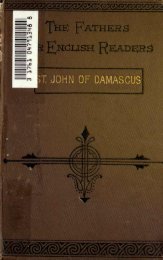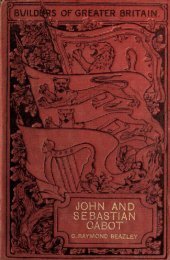- Page 2: [BRARY [HE UNIVERSITY OF CAL [FORNI
- Page 7 and 8: A HISTORY OF SPANISH LITERATURE BY
- Page 9 and 10: PQ Tssll PREFACE SPANISH literature
- Page 11: PREFACE My debts to predecessors wi
- Page 15 and 16: A HISTORY OF SPANISH LITERATURE CHA
- Page 17 and 18: THE BASQUE FACTOR 3 retouched and "
- Page 19 and 20: THE SPANISH ROMANS 5 in Martial's u
- Page 21 and 22: THE GOTHIC FACTOR 7 poetry, soldier
- Page 23 and 24: PRUDENTI US : OROSIUS 9 he deserves
- Page 25 and 26: THE JEWISH REVIVAL n scarcely less
- Page 27 and 28: MAIMONIDES 13 to say, of Albertus M
- Page 29 and 30: THE ARAB FALLACY 15 therefore long
- Page 31 and 32: THE ARABIC INFLUENCE 17 loquial Ara
- Page 33 and 34: ALJAMfA 19 with their fathers' spee
- Page 35 and 36: THE ARAB DECADENCE 21 by the Abbot
- Page 37 and 38: THE TRIUMPH OF CASTILIAN 23 people
- Page 39 and 40: THE MYTHIC CANTILENAS 25 to say tha
- Page 41 and 42: THE JUGLAR 27 early verse, is used
- Page 43 and 44: THE TROVADCR 29 liana's is "a numer
- Page 45: THE TROVADOR 31 savour), holds his
- Page 49 and 50: THE FRENCH INFLUENCE 35 his History
- Page 51 and 52: INTERMEDIATE VERSE 37 and gentlemen
- Page 53 and 54: LOST CANCIONEROS 39 And Alfonso's o
- Page 55 and 56: THE CASTILIAN REACTION 41 Castilian
- Page 57 and 58: CHAPTER II THE ANONYMOUS AGE 1150-1
- Page 59 and 60: MISTERIO DE LOS MAGOS 45 office, th
- Page 61 and 62: POEMA DEL CID 47 and mutilated. The
- Page 63 and 64: THE CID AND ROLAND 49 example prove
- Page 65 and 66: THE AUTHOR OF THE POEMA 51 Indubita
- Page 67 and 68: CANTAR DE RODRIGO 53 modern devices
- Page 69 and 70: LOPE DE MOROS 55 upon the Flight in
- Page 71 and 72: CHAPTER III THE AGE OF ALFONSO THE
- Page 73 and 74: BERCEO 59 literary tradition. Berce
- Page 75 and 76: BERCEO 6 1 invents a detail of his
- Page 77 and 78: ALFONSO THE LEARNED 63 early Spanis
- Page 79 and 80: sought to prove ALFONSO THE LEARNED
- Page 81 and 82: ALFONSO'S COLLABORATORS 67 blush to
- Page 83 and 84: ALFONSO'S CANTIGAS 69 embody in the
- Page 85 and 86: KALILAH AND DIMNAH 71 For his part,
- Page 87 and 88: SANCHO IV. 73 taken by his order du
- Page 89 and 90: HISTORIA DE YUSUF 75 Whoever the wr
- Page 91 and 92: JUAN RUIZ 77 never a more grotesque
- Page 93 and 94: JUAN RUIZ 79 resemblance be- given
- Page 95 and 96: JUAN MANUEL 81 latter shared in the
- Page 97 and 98:
JUAN MANUEL 83 Book, addressed to h
- Page 99 and 100:
ALFONSO ONCENO 85 charge ; and it i
- Page 101 and 102:
SEM TOB 87 rare and distant interva
- Page 103 and 104:
AYALA 89 father's defection in such
- Page 105 and 106:
AYALA 91 Cancionero de Baena (No. 5
- Page 107 and 108:
CHAPTER V THE AGE OF JUAN II. 1419-
- Page 109 and 110:
VILLENA 95 inopportune learning wit
- Page 111 and 112:
MACfAS: RODRfGUEZ 97 where a jealou
- Page 113 and 114:
SANTILLANA 99 tillana, in reviewing
- Page 115 and 116:
MENA 101 mere fact that Juan II.'s
- Page 117 and 118:
PREZ DE GUZMAN 103 but, as an authe
- Page 119 and 120:
CLAVIJO: GAMEZ 105 An interesting p
- Page 121 and 122:
MARTINEZ: LUCENA 107 ALFONSO MARTIN
- Page 123 and 124:
CHAPTER VI THE AGE OF ENRIQUE CATHO
- Page 125 and 126:
MINGO REVULGO in and Sarmiento's as
- Page 127 and 128:
GOMEZ MANRIQUE 113 rebellion of the
- Page 129 and 130:
JORGE MANRIQUE 115 but the theory i
- Page 131 and 132:
PALENCIA 117 tential Psalms, which
- Page 133 and 134:
PADILLA 119 in Asenjo Barbieri's Ca
- Page 135 and 136:
ENCINA 121 amorist. The dialogue is
- Page 137 and 138:
AMADlS DE GAULA 123 out, the sacred
- Page 139 and 140:
ROJAS 125 The first instance of its
- Page 141 and 142:
PULGAR: COLUMBUS 127 because of its
- Page 143 and 144:
.tr CHAPTER VII THE AGE OF CARLOS Q
- Page 145 and 146:
LEON HEBREO 131 of Burgos ; Petrarc
- Page 147 and 148:
TORRES NAHARRO 133 Naples in 1517 w
- Page 149 and 150:
GIL VICENTE 135 view stage-effects
- Page 151 and 152:
BOSCAN 137 in the year 1526, Navagi
- Page 153 and 154:
BOSCAN 139 Moreover, it was the sin
- Page 155 and 156:
BOSCAN 141 adjective there can be n
- Page 157 and 158:
GARCILASO 143 by all beholders by t
- Page 159 and 160:
GARCILASO 145 Auzi'as March, no dou
- Page 161 and 162:
GARCILASO 147 secular renown, but t
- Page 163 and 164:
CETINA: ACUftA 149 gals are excelle
- Page 165 and 166:
MENDOZA: CASTILLEJO 151 Plenipotent
- Page 167 and 168:
VILLEGAS: SILVESTRE 153 of Bottom t
- Page 169 and 170:
GUEVARA 155 GUEVARA (d. 1545), a Fr
- Page 171 and 172:
CORTES: BERNAL DIAZ 157 Indians is
- Page 173 and 174:
THE PICARESQUE NOVEL 159 son of the
- Page 175 and 176:
JUAN DE AVILA fry/vc the earlier is
- Page 177 and 178:
JUAN DE VALDES 163 just without bei
- Page 179 and 180:
CHAPTER VIII THE AGE OF FELIPE II.
- Page 181 and 182:
LOPE DE RUEDA 167 of four white she
- Page 183 and 184:
LOPE DE RUEDA 169 interlude turning
- Page 185 and 186:
oth in Latin and Castilian ; MALARA
- Page 187 and 188:
BERMUDEZ: ARTIEDA 173 vein the vein
- Page 189 and 190:
VIRUES: ARGENSOLA 175 essayed the e
- Page 191 and 192:
HERRERA 177 cated much of his verse
- Page 193 and 194:
HERRERA 179 in this spirit, aided b
- Page 195 and 196:
LUIS DE LE6N 181 cular. In March 15
- Page 197 and 198:
LUIS DE LE6N 183 of the Bishop of C
- Page 199 and 200:
TORRE AND QUEVEDO 185 rally forgott
- Page 201 and 202:
FIGUEROA 187 Italy. To conceive tha
- Page 203 and 204:
BARAHONA RUFO 189 BARAHONA DE SOTO
- Page 205 and 206:
posed ERCILLA 191 in either America
- Page 207 and 208:
SANTA TERESA 193 Such as then was a
- Page 209 and 210:
SANTA TERESA 195 Her masterpiece is
- Page 211 and 212:
SANTA TERESA 197 tude ; the faculti
- Page 213 and 214:
SAN JUAN DE LA CRUZ 199 spiritual r
- Page 215 and 216:
LUIS DE GRANADA 201 Council of Tren
- Page 217 and 218:
ARIAS MONTANO 203 of Northern think
- Page 219 and 220:
MONTEM6R 20$ have been a certain An
- Page 221 and 222:
ZURITA 207 Amor (1573), wherein Fre
- Page 223 and 224:
MENDOZA 209 lucky accident we owe t
- Page 225 and 226:
CHAPTER IX THE AGE OF LOPE DE VEGA
- Page 227 and 228:
CERVANTES 2 i 3 of the house he bro
- Page 229 and 230:
CERVANTES THE SOLDIER 215 sages wit
- Page 231 and 232:
THE GALATEA 217 classing the sonnet
- Page 233 and 234:
THE GALATEA 219 pany. In his Fourth
- Page 235 and 236:
CERVANTES THE DRAMATIST 221 of Zara
- Page 237 and 238:
THE NUMANCIA 223 Ye spirits vile, i
- Page 239 and 240:
THE NUMANCIA 225 Here, once more, w
- Page 241 and 242:
DON QUIXOTE 227 Vega's Dragontea (1
- Page 243 and 244:
DON QUIXOTE 229 Brown have industri
- Page 245 and 246:
DON QUIXOTE 231 author made his ons
- Page 247 and 248:
CERVANTES IN JAIL 233 and Don Quixo
- Page 249 and 250:
THE NOVELAS EXEMPLARES 235 and lowe
- Page 251 and 252:
THE VIAJE DEL PARNASO 237 that auth
- Page 253 and 254:
AVELLANEDA 239 imitation of Don Qui
- Page 255 and 256:
LOPE DE VEGA 241 smilingly confront
- Page 257 and 258:
LOPE THE SOLDIER 243 and therefore
- Page 259 and 260:
THE DRAGONTEA 245 makes no pretence
- Page 261 and 262:
LOPE'S SONNETS 247 How without guil
- Page 263 and 264:
LOPE THE PRIEST 249 Cold blasts whe
- Page 265 and 266:
THE FILOMENA 251 once seen and hear
- Page 267 and 268:
LOPE'S VERSATILITY 253 voluminous p
- Page 269 and 270:
LOPE'S FACILITY 255 Such force has
- Page 271 and 272:
are a most brilliant progeny ; LOPE
- Page 273 and 274:
LOPE'S DIALOGUE 259 Teodor^ Show mo
- Page 275 and 276:
LOPE'S FAULTS AND VIRTUES 261 sion.
- Page 277 and 278:
LOPE'S IMITATORS 263 passion of the
- Page 279 and 280:
he owes his revival ; LOPE'S ACHIEV
- Page 281 and 282:
MATED ALEMAN 267 with an insistence
- Page 283 and 284:
PfiREZ DE HITA 269 fifth siring to
- Page 285 and 286:
ANTONIO P^REZ 271 Of minor singers,
- Page 287 and 288:
MARIANA 273 In 1599 there appeared
- Page 289 and 290:
CHAPTER X THE AGE OF FELIPE IV. AND
- Page 291 and 292:
THE ARGENSOLAS 277 order of the Con
- Page 293 and 294:
GONGORA 279 Much meritorious academ
- Page 295 and 296:
'Jt&fe GONGORA'S FIRST MANNER 281 V
- Page 297 and 298:
GGNGORAS SECOND MANNER 283 We love
- Page 299 and 300:
EUPHUISM AND GONGORISM 285 shape. T
- Page 301 and 302:
THE SOLEDADES 287 Three helmsmen of
- Page 303 and 304:
G6NGORA AND LOPE 289 there is but o
- Page 305 and 306:
GONGORISM TRIUMPHANT 291 amour with
- Page 308 and 309:
294 SPANISH LITERATURE / rambled by
- Page 310 and 311:
296 SPANISH LITERATURE the Queen wa
- Page 312 and 313:
298 SPANISH LITERATURE Roca y Serna
- Page 314 and 315:
300 SPANISH LITERATURE was less lik
- Page 316 and 317:
302 SPANISH LITERATURE in December
- Page 318 and 319:
304 SPANISH LITERATURE de los Perro
- Page 320 and 321:
306 SPANISH LITERATURE her duty are
- Page 322 and 323:
308 SPANISH LITERATURE a name, and
- Page 324 and 325:
310 SPANISH LITERATURE opinion of h
- Page 326 and 327:
312 SPANISH LITERATURE playwright i
- Page 328 and 329:
314 SPANISH LITERATURE indecency. Y
- Page 330 and 331:
316 SPANISH LITERATURE Council for
- Page 332 and 333:
318 SPANISH LITERATURE Y RiAfJo (16
- Page 334 and 335:
320 SPANISH LITERATURE Come, sudden
- Page 336 and 337:
322 SPANISH LITERATURE So high and
- Page 338 and 339:
324 SPANISH LITERATURE " Who that i
- Page 340 and 341:
326 SPANISH LITERATURE Juan (coming
- Page 342 and 343:
328 SPANISH LITERATURE and the auto
- Page 344 and 345:
330 SPANISH LITERATURE imply some c
- Page 346 and 347:
332 SPANISH LITERATURE all the gold
- Page 348 and 349:
334 SPANISH LITERATURE CAVA&A (1618
- Page 350 and 351:
336 SPANISH LITERATURE a most disti
- Page 352 and 353:
338 SPANISH LITERATURE model of ene
- Page 354 and 355:
340 SPANISH LITERATURE matic amplif
- Page 356 and 357:
342 SPANISH LITERATURE no Spanish v
- Page 358 and 359:
344 SPANISH LITERATURE les etrivier
- Page 360 and 361:
346 SPANISH LITERATURE like his con
- Page 362 and 363:
348 SPANISH LITERATURE him to negle
- Page 364 and 365:
350 SPANISH LITERATURE critico owes
- Page 366 and 367:
352 SPANISH LITERATURE good faith ;
- Page 368 and 369:
354 SPANISH LITERATURE expelled fro
- Page 370 and 371:
356 SPANISH LITERATURE performance
- Page 372 and 373:
, * 358 SPANISH LITERATURE Fits Nat
- Page 374 and 375:
360 ?> C^_ LSI**-/ SPANISH LITERATU
- Page 376 and 377:
362 SPANISH LITERATURE a physical c
- Page 378 and 379:
364 SPANISH LITERATURE It is a stri
- Page 380 and 381:
' 366 SPANISH LITERATURE melodies :
- Page 382 and 383:
368 SPANISH LITERATURE This is as c
- Page 384 and 385:
370 SPANISH LITERATURE summate addr
- Page 386 and 387:
372 SPANISH LITERATURE by ranking h
- Page 388 and 389:
374 SPANISH LITERATURE often wearis
- Page 390 and 391:
376 SPANISH LITERATURE astute haran
- Page 392 and 393:
378 SPANISH LITERATURE The three vo
- Page 394 and 395:
380 SPANISH LITERATURE been elabora
- Page 396 and 397:
382 SPANISH LITERATURE campaign cal
- Page 398 and 399:
384 SPANISH LITERATURE turned to me
- Page 400 and 401:
386 SPANISH LITERATURE with all his
- Page 402 and 403:
388 SPANISH LITERATURE cation dates
- Page 404 and 405:
390 SPANISH LITERATURE with town li
- Page 406 and 407:
392 I ./ f i V . SPANISH LITERATURE
- Page 408 and 409:
394 SPANISH LITERATURE the Sra. Par
- Page 410 and 411:
396 SPANISH LITERATURE DE ARCE (b.
- Page 412 and 413:
398 SPANISH LITERATURE Emilio Cotar
- Page 414 and 415:
400 BIBLIOGRAPHY Garcia (1884), F.
- Page 416 and 417:
402 BIBLIOGRAPHY case against the p
- Page 418 and 419:
404 BIBLIOGRAPHY CHAPTER IV Most of
- Page 420 and 421:
406 1873) ; and by Luclwig BIBLIOGR
- Page 422 and 423:
408 BIBLIOGRAPHY in his Biblioteca
- Page 424 and 425:
410 BIBLIOGRAPHY lent. Edmund Borer
- Page 426 and 427:
412 BIBLIOGRAPHY Mori's invaluable
- Page 428 and 429:
414 Bances Candamo, Francisco Anton
- Page 430 and 431:
4i6 Enrique IV., Cr6nica de, 117 En
- Page 432 and 433:
Isidore Pacensis, II 1 Isla, Franci
- Page 434 and 435:
420 Mosquerade Figueroa, Cristobal,
- Page 436 and 437:
422 Santisteban y Osorio, Diego, 19
- Page 442:
. ' t

















